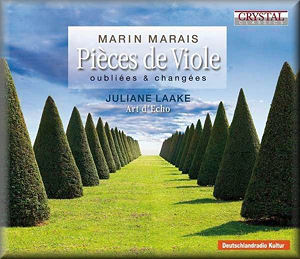 |
 |
|


alternatively
CD: MDT
|
Marin MARAIS (1656 - 1728)
Pièces de viole oubliées et changées
Suite in A (1686) [21:15]
Suite in C* (1711) [23:08]
Suite in G (1701) [26:15]
 Juliane Laake (descant viol*, bass viol)
Juliane Laake (descant viol*, bass viol)
Art d'Echo (Katharina Schlegel (bass viol), Ophira Zakai (theorbo),
Sabine Erdmann (harpsichord))
rec. 8-11 February 2010, Siemensvilla, Berlin, Germany. DDD
 CRYSTAL CLASSICS N67065 [70:42]
CRYSTAL CLASSICS N67065 [70:42] 
|
|
|
Marin Marais is one of the most famous composers of the baroque
era. His oeuvre for the viola da gamba is unique in its technical
brilliance and depth. He was celebrated in his own time as one
of the greatest. But even now there are still things which are
hardly known as the title of this discs suggests: 'Pièces de
viole oubliées' - forgotten viol pieces. The other word, 'changées'
(changed), refers to the scoring of the Suite in C which
is played here on the descant viol or dessus de viole,
as it was called in France.
Marais was hailed not only as a great composer and virtuosic
player of the viola da gamba. French traditionalists also considered
him the best defence against the assaults of Italian music.
In 1740 Hubert Le Blanc, one of the staunchest defenders of
the French style, wrote: "Marais was so skilful in his
domain, had such a refined way of composing and such an elaborate
playing technique, which was aligned to unmistakable norms,
that he (...) could hold out against the attack, which the Romans,
Florentines and Neapolitans pursued against France". The
difference should not be exaggerated, though. One thing which
strikes me when I listen to Marais's music, is that many pieces
are quite theatrical, no less than pieces by the best Italian
composers of his time.
The Suite in A from the first book (1686) begins with
a prélude which works as a powerful statement. It is
followed by a playful boutade which can probably best
be translated as 'wit'. All three suites have an allemande
with a double, and they belong to the most impressive
movements, technically and musically. The sarabande of
this suite is an expressive piece, which is followed by a gigue
with pronounced rhythmic accents. The suite closes with a brilliant
rondeau.
The Suite in C is from the third book which was printed
in 1711. Although Marais composed his pieces for the bass viol
he suggested in the preface of this book that his suites could
be played on the descant viol as well. This instrument had become
quite popular at that time. Even in Germany composers with a
special liking for the French style wrote music for this instrument,
for instance Georg Philipp Telemann and Johann Melchior Molter.
It was considered a better - and more 'French' - alternative
to the violin. It was praised for its delicate and tender sound,
and that comes well off in the performance of this suite. The
prélude lentement which opens the suite is a good example
of these qualities as well as the short caprice which
follows it. In the allemande and its double the
lower range of the instrument is explored. These are two bubbling
pieces, showing that there is more to the descant viol than
just delicacy. This suite also includes a character piece, referring
to the fashion of drinking coffee which had emerged in the last
quarter of the 17th century: saillie du Caffé, again
with a double. The suite closes with a chaconne.
In the Suite in G from the second book (1701) Juliane
Laake returns to the bass viol. The suite begins with a prélude
in two sections, slow - fast. There are again some character
pieces. Here we have a sarabande la désolée. The slow
tempo, the musical figures and the pauses perfectly express
the sadness the title suggests. It is followed by a lively gigue
la badine. I'm not quite sure what to make of it. A badine
is a riding whip in English. So maybe this is a reference to
horse-riding, also considering that the penultimate movement
is called rondeau champêtre, referring to the life at
the countryside. This was a popular subject in France at the
time. In his books with harpsichord pieces François Couperin
also regularly refers to the countryside. The suite ends with
a chaconne en rondeau, combining two of the most popular
forms of the time.
This is one of the most engaging and captivating discs with
gamba pieces I have heard recently. Juliane Laake is a pupil
of Hille Perl and Philippe Pierlot, two of the world's leading
viola da gamba players. She herself should be ranked among the
very best as this disc shows. The intimate pieces are played
with refinement, and in the more extroverted movements she gives
all she's got. She and her colleagues have a very good feeling
for the often pronounced rhythms. They can really make you move
your feet. The fact that they have avoided the most obvious
parts of Marais's oeuvre only increases the attraction of this
disc. It is not to be missed.
Johan van Veen
http://www.musica-dei-donum.org
https://twitter.com/johanvanveen
|
|

